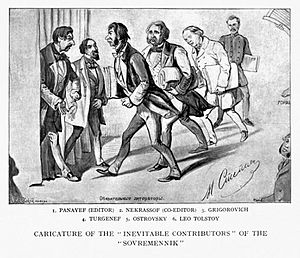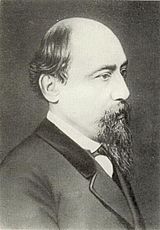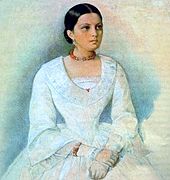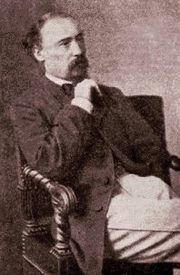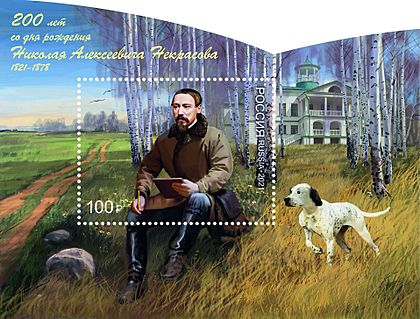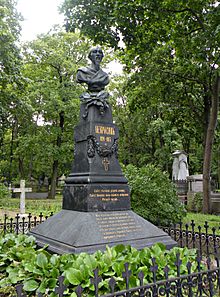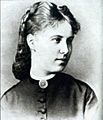Nikolay Nekrasov facts for kids
Quick facts for kids
Nikolay Nekrasov
|
|
|---|---|
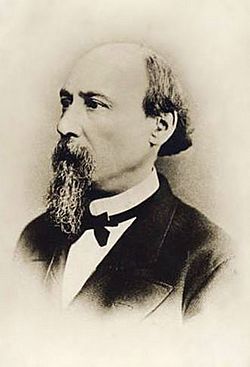
Nekrasov in 1870
|
|
| Born | Nikolay Alexeyevich Nekrasov 10 December [O.S. 28 November] 1821 Nemyriv, Bratslavsky Uyezd, Podolia Governorate, Russian Empire |
| Died | 8 January 1878 [O.S. 27 December 1877] (aged 56) Saint Petersburg, Russian Empire |
| Occupation | Poet, publisher |
| Language | Russian |
| Nationality | Russian |
| Spouse | Fyokla Viktorova |
| Signature | |
Nikolay Alexeyevich Nekrasov (Russian: Никола́й Алексе́евич Некра́сов, December 10, 1821 – January 8, 1878) was a famous Russian poet, writer, and publisher. He is known for his poems that showed deep care for the lives of Russian peasants. Many people in liberal and radical groups admired him, especially Vissarion Belinsky and Nikolay Chernyshevsky. Nekrasov brought new styles to Russian poetry, like using different rhythms and telling stories through a single character's speech. He was also a very successful and important editor of several literary magazines, including Sovremennik.
Contents
Nikolay Nekrasov's Life Story
Growing Up in Russia
Nikolay Alexeyevich Nekrasov was born in Nemyriv, which is now in Ukraine. His father, Alexey Sergeyevich Nekrasov, was an army officer. There is some debate about his mother's background. Some say she was a Polish noblewoman, while others believe she was the daughter of a Ukrainian official.
In 1823, when Nikolay was young, his father retired from the army. The family moved to their estate in Greshnevo, near the Volga River. Nikolay spent his childhood there with his five brothers and sisters. His father often became angry, which was hard for the family. These difficult experiences deeply affected Nikolay. They later inspired him to write about the struggles of Russian peasants and women. Nikolay's mother loved books and shared this love with her son. Her support helped him through his tough childhood.
School and First Writings
In 1832, Nekrasov started school at the Yaroslavl Gymnasium. He left early, possibly because his father wanted him to join the military. His father also did not want to pay for his education. In 1837, Nikolay had to stay home for a year. Even though the school was not great, Nekrasov's love for poetry grew there. He admired poets like Byron and Pushkin.
Nekrasov decided to go to Saint Petersburg on his own. His father was angry that he refused to join the army and stopped supporting him financially. For three years, Nikolay lived in very difficult conditions. He sometimes had no home. Things improved when he started giving lessons and writing for newspapers. He wrote children's books and plays under the name Perepelsky. In 1838, his first poem, "Thought," was published. He also studied at Saint Petersburg University for a short time.
In 1840, Nekrasov published his first poetry book, Dreams and Sounds. He used only his initials, "N. N.," because his mentor, Vasily Zhukovsky, thought he might be embarrassed by it later. Some critics did not like the book, and Nekrasov later destroyed most of the unsold copies. However, this book already showed the main ideas that would appear in his later, more famous poems.
Becoming a Literary Figure
Nekrasov's first literary teacher, Fyodor Koni, helped him start as a literary critic. Soon, Nekrasov became a very active writer. He wrote satires (funny criticisms) and plays for different publications. He always loved theater, and his best poems often felt like plays.
In 1841, Nekrasov began writing for Andrey Krayevsky's Otechestvennye Zapiski magazine. In 1842, after his mother passed away, Nekrasov went back to Greshnevo. He made peace with his father, who was now proud of his son's success.
In 1843, Nekrasov met Vissarion Belinsky, a very important critic. Belinsky was interested in ideas about social fairness, and Nekrasov, who had seen the harshness of serfdom (a system where peasants were tied to the land) on his father's estate, agreed with him. Nekrasov's early poems, "On the Road" (1845) and "Motherland" (1846), were praised by Belinsky. Nekrasov later said that his talks with Belinsky changed his life.
In the mid-1840s, Nekrasov put together and published two important collections of writings: The Physiology of Saint Petersburg (1845) and Saint Petersburg Collection (1846). The second one included Fyodor Dostoyevsky's first novel, Poor Folk. These books helped to promote a new style of writing called realism in Russia. This style focused on showing life as it really was.
Leading Literary Magazines
The Sovremennik Years
In 1846, Nekrasov and Ivan Panayev bought a popular magazine called Sovremennik (The Contemporary). It had been started by Alexander Pushkin. Nekrasov quickly brought many talented writers to the magazine, including Belinsky. Over the next few years, Sovremennik published works by famous authors like Ivan Turgenev, Ivan Goncharov, and Alexander Hertzen. Nekrasov even discovered Leo Tolstoy, who published his first stories in Sovremennik.
Nekrasov managed to keep the magazine going during a difficult time (1848-1855) when it was almost shut down. He was also watched by the secret police. To fill the magazine when censors cut out articles, he wrote long novels with Avdotya Panayeva, his partner. He also made friends with censors by inviting them to dinners.
In 1854, Nekrasov invited Nikolai Chernyshevsky to join Sovremennik, and later Nikolai Dobrolyubov became a key writer. This made the magazine more focused on radical ideas. In 1859, a negative review by Dobrolyubov made Turgenev leave the magazine. But many young, radical writers continued to join. In 1858, Nekrasov and Dobrolyubov started Svistok (Whistle), a funny addition to Sovremennik.
In June 1862, Sovremennik was closed by the government. Chernyshevsky was arrested. In December, Nekrasov managed to get the magazine reopened. In 1863, he published What Is to Be Done? by Chernyshevsky, who was still in prison.
Success and Challenges
In 1855, Nekrasov began putting together his first collection of poems. It was published in October 1856 and was very popular. Chernyshevsky wrote that "The rapture is universal." Turgenev said, "Nekrasov's poems… brandish like fire." Many people thought Nekrasov was even more popular than Pushkin at that time.
The end of serfdom in 1861 did not impress Nekrasov. He felt it was not true freedom for the peasants. His poems like "Freedom" and Korobeiniki (1861) showed his feelings. Korobeiniki was part of a series of books Nekrasov started for peasants, but the government soon banned them.
In 1862, after his father died, Nekrasov bought the Karabikha estate. He visited it every year until his own death.
In April 1866, after someone tried to harm the Tsar, Nekrasov wrote poems praising those who protected the Tsar. He did this to try and save Sovremennik. However, in May 1866, Sovremennik was closed for good.
At the end of 1866, Nekrasov bought Otechestvennye Zapiski (Notes of the Fatherland) magazine. He became its editor. He brought in new writers like Alexander Ostrovsky and Gleb Uspensky.
In 1869, Otechestvennye Zapiski began publishing Nekrasov's most famous poem, Who Is Happy in Russia? (1863–1876). This poem became an inspiration for revolutionary groups.
Illness and Passing
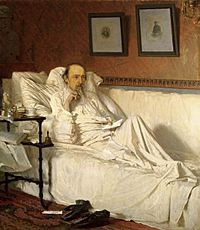
For many years, Nikolay Nekrasov suffered from a throat illness. In 1876, he had severe pain and could not sleep. Doctors advised him to go to the Crimea. In September 1876, he arrived in Yalta and continued working on the last part of Who Is Happy in Russia?. This part was banned by censors but was copied by hand and spread throughout Russia. In December, doctors diagnosed him with intestinal cancer.
In February 1877, students came to Yalta to support the dying poet. The painter Ivan Kramskoy came to paint his portrait. One of the last people Nekrasov met was Ivan Turgenev, who came to make peace after years of disagreement. A surgery in April 1877 helped for a short time.
Nikolay Alekseyevich Nekrasov passed away on January 8, 1878. Four thousand people came to his funeral. The procession to the Novodevichy Cemetery became a large political gathering. Fyodor Dostoyevsky gave a speech, calling Nekrasov one of the greatest Russian poets. Many people, especially those who wanted social change, believed he was even greater. His funeral showed how much people admired him.
Nekrasov's Personal Life
Nikolay Nekrasov met Avdotya Panayeva in 1842. She was already a promising writer and hosted a popular literary salon. Nekrasov fell in love with her.
The Panayevs' home became the unofficial meeting place for Sovremennik magazine. Nekrasov and Panayeva wrote two long novels together, Three Countries of the World (1848-1849) and The Dead Lake (1851). These books helped fill the magazine when censors cut other articles.
Nekrasov wrote many poems for and about Avdotya. These poems tell the story of their passionate and often difficult love. Some of these poems became popular songs. One of them, "Forgive! Forget the days of the fall...", was set to music by many Russian composers.
In 1849, Panayeva gave birth to a son, but he died soon after. The death of Ivan Panayev in 1862 also pulled the couple further apart. Panayeva eventually left Nekrasov because of his difficult personality. He often felt sad, angry, and could be very irritable.
In 1863, while still with Panayeva, Nekrasov met a French actress named Celine Lefresne. She became his lover. Nekrasov helped Celine financially and left her a large sum of money when he died.
In 1870, Nekrasov met 19-year-old Fyokla Anisimovna Viktorova. He gave her the new name Zinaida Nikolayevna. He taught her personally, and she learned many of his poems by heart, becoming his literary secretary. Nekrasov's friends respected Zina, but his sister did not like their relationship at first. They later made peace. On April 7, 1877, Nekrasov married Zinaida Nikolayevna at his home.
Nekrasov's Important Works
Nekrasov's first poetry collection, Dreams and Sounds, was not well-received by Vissarion Belinsky. However, Belinsky was the first to see Nekrasov's talent as a sharp and realistic writer. Belinsky was very excited by Nekrasov's poem "On the Road" (1845) and "Motherland" (1846).
The Poems by N. Nekrasov, published in October 1856, made him famous. This collection was divided into four parts. It started with "The Poet and the Citizen," which was like a statement of his beliefs. The poems covered real people's lives, criticized "enemies of the people," and explored love and friendship. The poem Sasha (1855) praised the new generation of politically aware Russians. This collection was re-published many times and grew larger over the years.
From 1855 to 1862, Nekrasov was very active in his writing. His important poem "Musings By the Front Door" (1858) was banned in Russia but published in Alexander Hertzen's newspaper Kolokol. Other poems like "The Song for Yeryomushka" (1859) became a revolutionary song for young people.
Nekrasov responded to the end of serfdom in 1861 with Korobeiniki (1861). This was a sad but funny story about two traveling salesmen who sold goods and gathered news across Russia. A part of this poem became a very popular folk song.
Other well-known poems from the early 1860s include "Peasant Children" (1861), which showed the good values of Russian peasants. "A Knight for an Hour" (1862) was written after he visited his mother's grave. "Orina, the Soldier's Mother" (1863) celebrated a mother's love. The Railway (1864) criticized Russian capitalism, saying it was built on the suffering of peasants.
"Grandfather Frost the Red Nose" (1864) praised the Russian spirit. In the late 1860s, Nekrasov published important satires. The Contemporaries (1865) criticized the rise of Russian capitalism and its dishonest supporters.
In 1867, Nekrasov started his Poems for Russian Children series, which he finished in 1873. Poems like "Grandfather Mazay and the Hares" and "General Stomping-Bear" are full of humor and kindness towards peasant children. They are still favorites among children in Russia today.
In the 1870s, Nekrasov's poetry became more serious and dramatic. He often presented the poet as someone serving "the throne of truth, love, and beauty." His later poems, like "The Morning" (1873) and "The Frightful Year" (1874), explored deeper ideas and looked back at past literary giants.
One of Nekrasov's most important works is his last, unfinished epic poem, Who Is Happy in Russia? (1863–1876). It tells the story of seven peasants who travel across Russia asking different people if they are happy. The answer is never truly satisfying. This poem is considered Nekrasov's masterpiece and sounds like a traditional Russian folk song.
Nekrasov's Impact and Legacy
Nikolai Nekrasov is seen as one of the greatest Russian poets of the 19th century, alongside Alexander Pushkin and Mikhail Lermontov. In the 1850s and 1860s, Nekrasov became a leader in Russian poetry that focused on social justice. He greatly influenced young people who wanted change. Many believed that Nekrasov's poetry, which spoke about the common people, encouraged students to connect with them.
Around 1860, a "Nekrasov school" of poetry began, bringing together realistic poets. Critics praised Nekrasov for starting "a new period in the history of Russian poetry."
Nekrasov was also the first editor of Fyodor Dostoevsky, whose first novel, Poor Folk, was published in Nekrasov's St. Petersburg Collection. This collection played a key role in promoting realism in Russian literature. As the long-time editor of Sovremennik, Nekrasov made it the leading Russian literary magazine of its time. He continued the work of Pushkin, who founded it. During his 20 years there, Sovremennik was a cultural hub for major Russian writers like Dostoevsky, Turgenev, and Tolstoy. However, some critics said Nekrasov was a "ruthless manipulator" who did not pay his writers enough.
Some people at the time saw him as a dangerous political agitator. Others, like Ivan Turgenev, were shocked by the "ugly, anti-social things" they felt crept into his poems. They also criticized his "antipoetic" style, saying he was "not an artist."
Despite these criticisms, Nekrasov's popularity grew, especially among young people who wanted radical change. Scholars today see Nekrasov as a pioneer in 19th-century Russian poetry. He explored new ways of writing that were unheard of before him. He mixed social awareness and political ideas with traditional poetry styles, opening new paths for later Russian Modernist poets.
Nekrasov made the Russian poetry language richer by adding elements of satire, everyday life, and, most importantly, folklore and song-like structures. Many believe he was the only 19th-century poet so close to the spirit of Russian folk songs. His poem Who Is Happy in Russia? is considered his greatest achievement in this style.
Nekrasov is also known as an innovative satirist. Before him, social satire in Russia was often very direct and judgmental. Nekrasov's style was different; he often showed the narrator being close to the character, using sarcasm and letting his characters speak for themselves.
What interested Nekrasov most was whether poetry could change the world. He became the most politically influential figure in 19th-century Russian literature. Even Vladimir Lenin called him "the great Russian Socialist."
However, Nekrasov also respected Orthodox Christianity and traditional Russian values. He had a strong need to create heroes, and the Russian people, his mother, and Belinsky were his main inspirations. His poetry was admired and quoted by people with many different political views. Many of his lines became common sayings in Russia.
It has been hard to judge Nekrasov's poetry objectively because people's opinions often depended on their political views. For a long time, even his admirers praised the ideas in his poetry more than his writing style. Only more recently have people fully appreciated his unique and original way of writing.
Remembering Nekrasov
In 1921, the 100th anniversary of his birth was celebrated. Nekrasov's estate in Karabikha, his home in St. Petersburg, and the office of Sovremennik magazine are now national museums of Russian literature. Many libraries are named in his honor, including the Central Universal Science Nekrasov Library in Moscow. A Ukrainian composer, Tamara Maliukova Sidorenko, set some of his poems to music.
Images for kids
-
Every summer Nekrasov would go hunting to his brother's estate of Karabikha near Yaroslavl (now a memorial museum).
See also
 In Spanish: Nikolái Nekrásov para niños
In Spanish: Nikolái Nekrásov para niños




